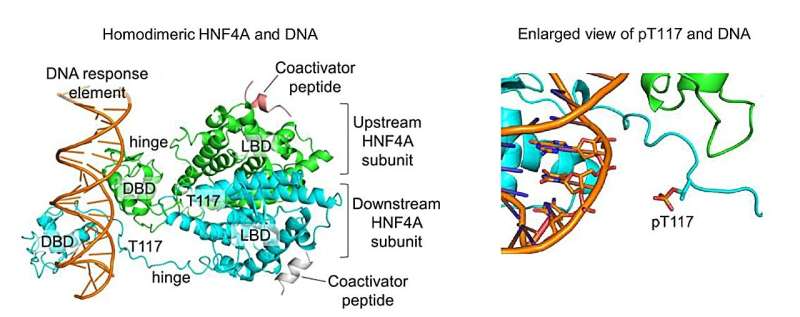This article has been reviewed according to Science X's editorial process and policies. Editors have highlighted the following attributes while ensuring the content's credibility:
fact-checked
peer-reviewed publication
trusted source
proofread
Molecular mapping reveals tissue-specific gene regulation by diabetes-linked transcription factors

Scientists have generated a comprehensive map of the gene targets regulated by the transcription factors HNF4A and HNF1A in human pancreatic beta cells and liver cells. Published in the journal Nature Communications, the study revealed common and tissue-specific molecular pathways regulated by HNF4A and HNF1A, two proteins that possess important functions governing the development and function of the pancreas and liver.
Notably, the scientists identified several novel gene targets in pancreatic beta cells, the cells responsible for insulin production, that may play previously unknown roles in regulating insulin secretion. As genetic variants in HNF4A and HNF1A are known to cause a rare form of diabetes called Maturity Onset Diabetes of the Young (MODY) and also influence risk for the more common type 2 diabetes, these findings provide valuable insights into potential therapeutic targets for diabetes.
The research team, led by Dr. Adrian Teo, Senior Principal Investigator at A*STAR's Institute of Molecular and Cell Biology (IMCB), used the cutting-edge technique of chromatin immunoprecipitation sequencing (ChIP-Seq) to map the genomic binding sites of HNF4A and HNF1A in stem cell-derived models of human pancreatic and liver cells, and in primary human islets.
By comparing the binding profiles across different cell types, they found that while these two transcription factors regulate some common genes and processes like actin cytoskeleton organization in both pancreatic beta cells and liver cells, they also exhibit tissue-specific binding patterns that correspond to the distinct functions of each cell type. For example, in liver cells, HNF4A preferentially bound to genes involved in cholesterol and fatty acid metabolism.
Zooming in on the pancreatic beta cell targets, the scientists shortlisted several high-confidence genes directly bound and regulated by HNF4A, including HAAO and USH1C, which have not been previously characterized in beta cells.
They showed that loss of HAAO or USH1C led to impaired glucose-stimulated insulin secretion in human beta cells, indicating that these genes regulate beta cell function.
Using a similar ChIP-Seq based approach, the study also investigated the molecular impact of a common genetic variant in HNF4A that is associated with type 2 diabetes risk.
The scientists found that this variant led to increased binding and activation of a small number of gene targets, suggesting a potential gain-of-function effect at specific gene regions that may influence diabetes predisposition.
"HNF4A and HNF1A are very important diabetes genes known to be regulating insulin secretion but their targets remained unclear," said Dr. Teo, the study's senior author.
"We are excited to further explore some of these novel targets or pathways which may serve as entry points for developing future diabetes therapies," added Dr. Teo.
"Our study provides the community with a comprehensive resource for investigating HNF4A and HNF1A gene targets in pancreatic beta cells and liver cells. By identifying key genes regulated by these two transcription factors in a tissue-specific manner, we shed light on their roles in normal tissue function and how their dysfunction may contribute to diabetes," said Dr. Natasha Ng, Senior Scientist at IMCB and the study's first author.
The team next aims to extend this molecular mapping approach to other diabetes-associated transcriptional regulators and mine the rich dataset to uncover more insights into disease-related mechanisms. They also plan to utilize genome editing tools to correct patient-specific variants in HNF4A and HNF1A to directly probe their effects in human stem cell-derived models.
More information: Natasha Hui Jin Ng et al, HNF4A and HNF1A exhibit tissue specific target gene regulation in pancreatic beta cells and hepatocytes, Nature Communications (2024). DOI: 10.1038/s41467-024-48647-w





















